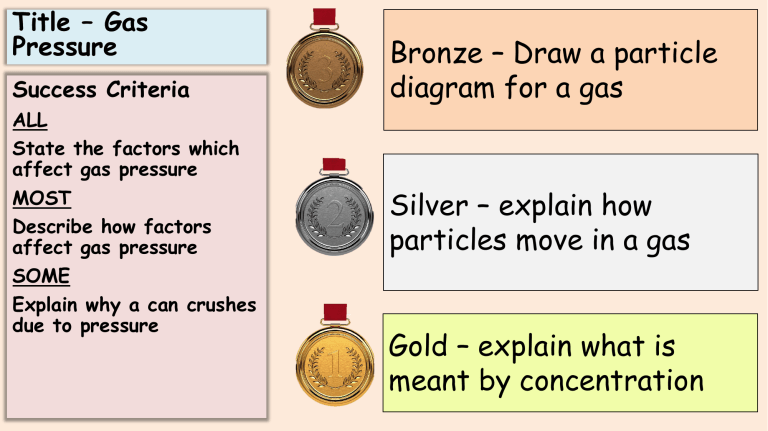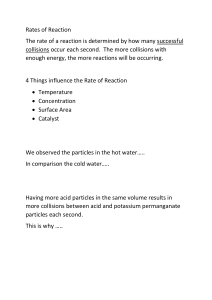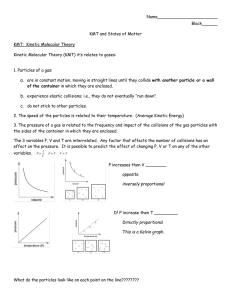
Title – Gas Pressure Success Criteria Bronze – Draw a particle diagram for a gas ALL State the factors which affect gas pressure MOST Describe how factors affect gas pressure SOME Explain why a can crushes due to pressure Silver – explain how particles move in a gas Gold – explain what is meant by concentration Gases have enough kinetic energy to move around, the molecules are not bonded Gases have ‘Brownian motion’ a random movement of particles caused by collisions Pressure Which Pressure means is the how force hardexerted are particles on a hitting the certain outside area of a container? Gas particles moving around in a container exert a certain amount of force on the outside of the container What effects pressure? Heat Concentration Heat Heat gives particles more kinetic energy so they move around quicker Faster collisions means higher pressure Concentration Particles collide – the more particles in an area the more they bump into each other More collisions means higher pressure Density Density = mass per unit volume Or… how much stuff do you have in a given area Why does my can crush? Heat means more kinetic energy, so bigger collisions so increase in pressure Cold water quickly cools down particles, big decrease in pressure, now more pressure from outside so it gets pushed in Can being pushed outwards by particles colliding with the can Watch these videos Explain why the tanker imploded • In your answer you should talk about • Thermal energy • Kinetic energy • Collisions with the container • Pressure • Internal pressure and atmospheric pressure – As the car is heated, thermal energy turns to kinetic energy as particles start to move around more – The internal pressure increases as the collisions with the outside are more frequent and larger – As the car is sealed these particles cannot escape. – When the car is exposed to the water the particles cool down rapidly, causing the internal pressure to drop – There is a greater number of particles colliding on the outside of the car compared to the inside of the car, – Therefore, the outside pressure crushed the car. Atmospheric pressure The air around your body exerts a force on your body – this is called atmospheric pressure Gravity pulls all particles to the ground, so more particles more pressure Extension – Explain how temperature affects pressure. Use the key word ‘kinetic energy’ in your answer Title – Gas Pressure Success Criteria ALL State the factors which affect gas pressure MOST Describe how factors affect gas pressure SOME Explain why a can crushes due to pressure Bronze – what is pressure? Silver – how can we increase pressure in a sealed container? Gold – what is atmospheric pressure Pressure = force per unit area Boyle’s Law Gas, pressure and volume all link In a sealed container with fixed temperature – the gas pressure is caused by the collisions If you decrease the volume the pressure increases How else can you increase the pressure? Boyle’s Law Boyle’s law states: "For a fixed mass of gas, at a constant temperature, the product of pressure and volume is equal to a constant.“ The volume of a fixed mass of gas, at constant temperature, is inversely proportional to the pressure. Pressure x Volume = Constant P x V = Constant Using Boyle’s Law Worked Example: Pressure x Volume = Constant P x V = Constant In an experiment, 200 cm3 of gas was collected in a flask at a pressure of 125 kPa. Calculate the volume of this mass of gas at a pressure of 100 kPa and the same temperature. Solution: P1 = 125 kPa and V1 = 200 cm3 So P1 x V1 = constant 125 x 200 = 25,000 P2 = 100 kPa and V2 needs to be worked out Rearrange equation to find Volume V2 = Constant ÷ P2 Constant ÷ Pressure = Volume 25,000 ÷ 100 = 250 cm3 Graph 100 X Data X X X 2 4 6 Data 10 What is wrong with this graph? 1. Plot the graph of this data 2. Describe the relationship shown in the graph (2) As temperature increases, pressure increases [1]; linearly [1] 3. Describe the movement of particles in a gas (2) Particles are far apart (relative to their size) [1]; and moving freely/rapidly [1]. They produce random collisions [1] They have lots of kinetic energy [1] 4.. Explain why the pressure on a container wall increases as the temperature of the gas increases (4) Thermal energy gives particles more kinetic energy [1] Particles move faster / gain kinetic energy (but do not move farther apart since container volume is fixed). Particles hit container walls more frequently [1]; and with more force (so average force per unit area, i.e. pressure, increases) [1]. 5. Explain what happens to a balloon, if it is taken underwater (4). Water has higher pressure than air [1] exerts a force on all sides of the balloon that is greater than in air [1] The pressure from the water causes the air to compress inside the balloon.[1] The deeper the balloon is taken into the water, the greater the pressure, and therefore, the smaller the balloon will become. [1] The pressure from the water will compress the balloon until the air pressure within the balloon can supply an equal amount of force against the water [1] 6.. A gas has a volume of 100 cm3and a pressure if 145Pa, what is the constant? Pressure x Volume = constant 100 x 145 = constant Constant = 14,500 6b. Use this answer to work out what happens when you increase the volume and decrease the volume As volume increases the pressure decreases As volume decreases the pressure increases 7. A gas is compressed from a volume of 75 cm3 to a volume of 30 cm3 its temperature remains the same. The pressure of the gas after it has been compressed is 110 Pa. What was the pressure of the gas before it was compressed? After compression; PV = constant, 30 x 110 = 3,300 Before compression; PV = constant, P x 75 = 3,300 P = 3,300 ÷ 75 = 44 Pa






